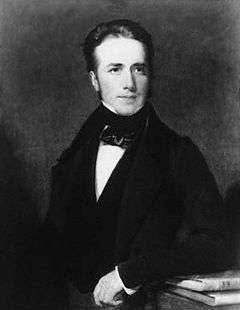Thomas Drummond
| Thomas Drummond | |
|---|---|
|
c. 1838 by Henry William Pickersgill | |
| Born |
10 October 1797 Edinburgh |
| Died | 15 April 1840 (aged 42) |
| Resting place |
Ireland Mount Jerome Dublin |
| Nationality | Scottish |
| Occupation | Civil engineer |
| Known for |
Cartography Drummond lamp |
| Spouse(s) | Maria Kinnaird |
| Children | three daughters |
| Signature | |
|
| |
Captain Thomas Drummond (10 October 1797 – 15 April 1840), from Edinburgh, Scotland, was an army officer, civil engineer and senior public official. Drummond used the Drummond light which was employed in the trigonometrical survey of Great Britain and Ireland. He is sometimes mistakenly given credit for the invention of limelight, at the expense of Sir Goldsworthy Gurney.[1] However, it was Drummond who realised their value in surveying.
Early life
Drummond was the second of three sons.[2] Despite his father dying when he was young, he credited his mother with getting him through his education at Edinburgh High School and then on to be a Royal Engineer cadet at Woolwich Academy in 1813. He showed an early gift for mathematics. After Woolwich he was stationed in Edinburgh and was involved with public works. He was bored with this and had enrolled at Lincolns Inn when he was recruited to use his trigonometry to help conduct a survey in the Highlands.[2]
This new work was done in the summer with the more difficult months being passed in London. Drummond took this opportunity to improve his knowledge of mathematics and science. He attended lectures by Sir Michael Faraday. At these he learned of the discovery of limelight.
Ordnance Survey of Ireland
In 1824 Drummond was transferred to the new Ordnance Survey of Ireland and here he used the new Drummond light.[3] He reported that the light could be observed 68 miles away and would cast a strong shadow at a distance of thirteen miles.[1] Drummond left Ireland for a period prior to the Reform Bill of 1832. For his services to the Whigs, acting as secretary to Lord Spencer, Lord Brougham had him awarded a pension 300 pounds per annum.[2]
In 1835 Drummond, now back with the Irish Survey, married the wealthy heiress Maria Kinnaird, who was the adopted daughter of the critic Conversation Sharp (1759–1835). They had three children, Emily, Mary and Fanny.[4]
Appointment as Irish under-secretary
He was then appointed to the significant post of Irish under-secretary, heading up the administration in Dublin Castle, a position he held from 1835 until his death in 1840. A supporter of the Whigs, Drummond was held in high regard by Irish, whom he treated with impartiality.[5]
Drummond died in 1840 and was buried in Mount Jerome Cemetery, Dublin. It was concluded by his family physician, Dr. Johnson, who spent his last days with Drummond, that he was afflicted with peritonitis, which was symptomatic of an undetermined medical cause.[6] It is believed by some that overwork and stress precipitated his premature death in 1840 after working unceasingly for five years as Irish under-secretary.
His dying words were reported as:
"I wish to be buried in Ireland, the country of my adoption a country which I loved, which I have faithfully served, and for which I believe I have sacrificed my life."[7]
See also
Notes
- 1 2 "Demonstrations 19 – Limelight". Leeds University. Retrieved 2011-03-21.
- 1 2 3 "Significant Scots – Thomas Drummond". Retrieved 2008-07-18.
- ↑ "Historic mapping – archive origins". Ordnance Survey of Ireland. Retrieved 2011-03-21.
- ↑ Kegan Paul (1891). Maria Drummond – A Sketch. Kegan Paul.
- ↑ 1907 edition of The Nuttall Encyclopædia
- ↑ O'Brien, R. Barry (1889). Thomas Drummond, under-secretary in Ireland, 1835-40 : life and letters. London: Kegan Paul, Trench & Company. p. 386. Retrieved 2011-03-21.
- ↑ O'Brien, R. Barry (1889). Thomas Drummond, under-secretary in Ireland, 1835-40 : life and letters. London: Kegan Paul, Trench & Company. pp. 387–388. Retrieved 2011-03-21.
References
- This article incorporates text from a publication now in the public domain: Wood, James, ed. (1907). "article name needed". The Nuttall Encyclopædia. London and New York: Frederick Warne.
Further reading
| Wikiquote has quotations related to: Thomas Drummond |
| Wikisource has the text of the 1911 Encyclopædia Britannica article Drummond, Thomas. |
- Larcom, T. A. (1840). "Memoir of the professional life of the late Captain Drummond". Papers on subjects connected with the duties of the corps of Royal Engineers. Woolwich. 4.
- O'Brien, R. Barry (1889). Thomas Drummond, under-secretary in Ireland, 1835-40 : life and letters. London: Kegan Paul, Trench & Company.
- McLennan, J. F. (1867). Memoir of Thomas Drummond. Edinburgh.
- Ó Tuathaigh, G. (1979). Thomas Drummond and the government of Ireland 1835–41. Galway.
- McLennan, John Ferguson; Drummond, Thomas (1867). Memoir of Thomas Drummond.
| Government offices | ||
|---|---|---|
| Preceded by unknown |
Under-Secretary for Ireland 1835–1840 |
Succeeded by Sir Thomas Aiskew Larcom |
